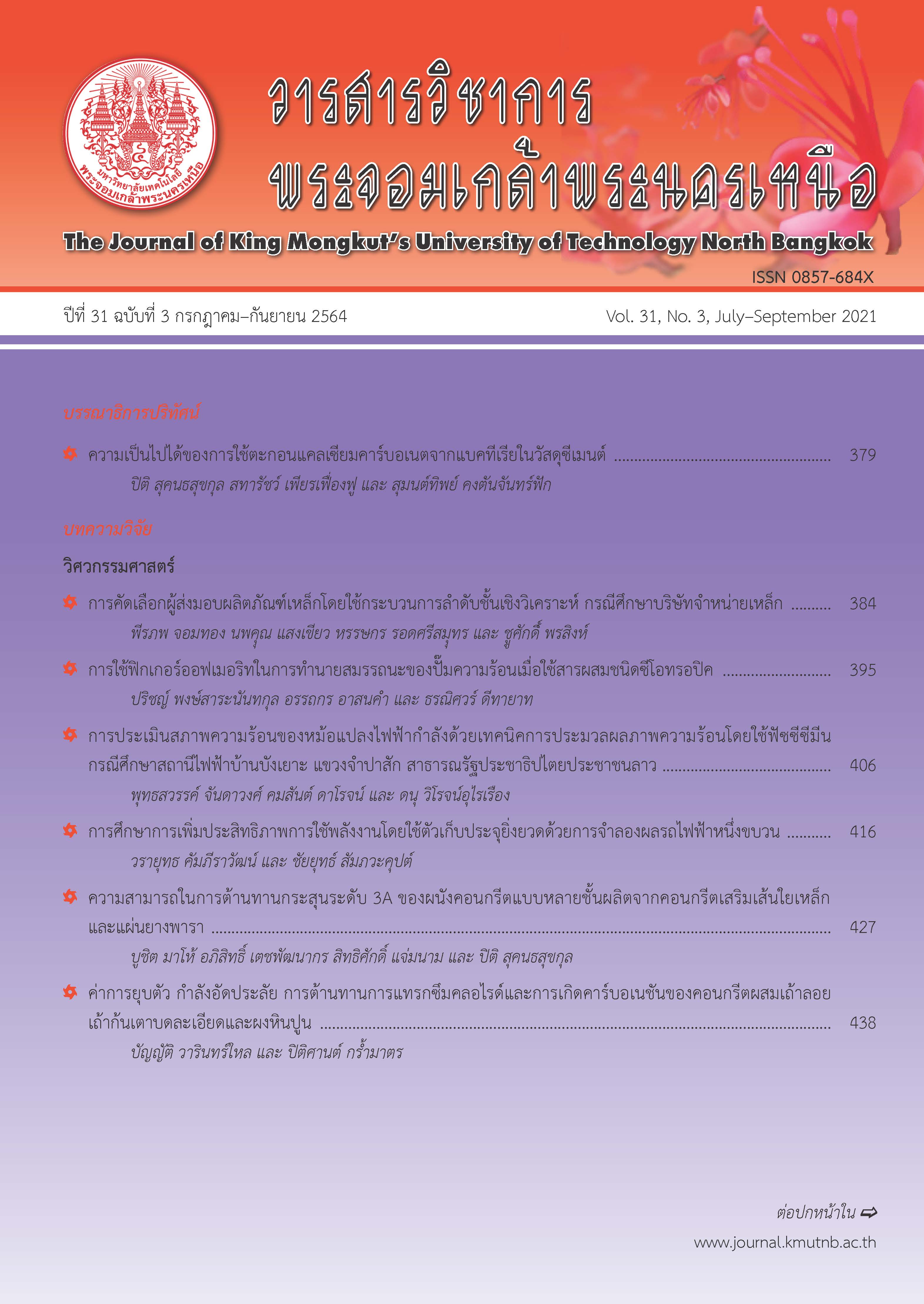หมึกพิมพ์ปลอดปลอมฐานสารยึดเซลลูโลสที่ตรวจสอบได้ด้วยแสงยูวีเอ
Main Article Content
บทคัดย่อ
หมึกพิมพ์ที่ตรวจสอบได้นับเป็นหนึ่งในเทคโนโลยีปลอดปลอมที่ช่วยในการยืนยันความถูกต้องของผลิตภัณฑ์ที่อาจถูกปลอมแปลง โดยเฉพาะในกลุ่มผลิตภัณฑ์ที่มีราคาสูง เนื่องจากเป็นวัสดุที่มีต้นทุนการผลิตต่ำ สามารถตรวจสอบได้ง่าย และสร้างความเชื่อมั่นให้กับผู้บริโภคได้เป็นอย่างดี งานวิจัยเรื่องนี้ จึงมีจุดประสงค์เพื่อพัฒนาหมึกพิมพ์ปลอดปลอมฐานสารยึดเซลลูโลสที่ตรวจสอบได้ด้วยแสงยูวี ประกอบด้วยแอนทราควิโนน-2-ซัลโฟเนต (ATQ) เป็นสารให้สี กลีเชอรอล (G) เป็นสารให้อิเล็กตรอน ร่วมกับสารยึดฐานเซลลูโลสที่สกัดได้จากกาบกล้วยน้ำว้า (CbB) และไทเทเนียมไดออกไซด์ (TiO2) เป็นสารเร่งปฏิกิริยาด้วยแสง โดยศึกษาความเข้มข้นของ TiO2 ที่ต่างกัน 3 ระดับ คือ 25, 50 และ100 ส่วนต่อหนึ่งร้อยส่วนสารยึด จากนั้น เตรียมเป็นหมึกพิมพ์ ทดสอบพิมพ์ และทดลองตรวจสอบด้วยแสง UVA ที่ความเข้ม 2.5 มิลลิวัตต์ต่อตารางเซนติเมตร ในสภาวะปลอดออกซิเจน พบว่า หมึกพิมพ์ทุกอัตราส่วนมีลักษณะเป็นเนื้อเดียว ไม่มีสี สามารถพิมพ์ลงบนวัสดุได้ดี เมื่อทดสอบการเปลี่ยนแปลงสีด้วยแสง UVA พบว่าหมึกพิมพ์จะค่อย ๆ เปลี่ยนสีจากไม่มีสีไปเป็นสีเหลืองเข้ม โดยอัตราเร็วในการเปลี่ยนแปลงสีขึ้นอยู่กับปริมาณของ TiO2 โดยตรง และจากการทดลองหมึกพิมพ์ที่มีปริมาณ TiO2 เท่ากับ 100 ส่วนต่อหนึ่งร้อยส่วนสารยึด มีอัตราเร็วเริ่มต้น (kin) สูงที่สุดคือ 0.9924 ?E.min-1 มีค่าความแตกต่างสีรวมสูงสุด (?Emax) ที่ 35.85 และมีเวลาที่หมึกเปลี่ยนแปลงสีได้ 95% ของสีสมบูรณ์ (t95) เป็น 3.97 ?0.38 นาที ตามลำดับ นอกจากนั้น ยังพบว่าเฉดสีเหลืองของหมึกพิมพ์หลังการตรวจสอบ สามารถเปลี่ยนแปลงไปเป็นสีเขียวอ่อนและสีน้ำตาลแดงได้เมื่อได้รับสารละลายกรดและด่าง ตามลำดับ ทั้งนี้ หมึกพิมพ์ในงานวิจัยนี้ ยังสามารถผันสีกลับได้เมื่อได้รับแก็สออกซิเจนจากการซึมผ่านวัสดุเคลือบ ทำให้สามารถผันสีกลับกลายเป็นไม่มีสีและตรวจสอบใหม่ได้หลายครั้ง
Article Details
บทความที่ลงตีพิมพ์เป็นข้อคิดเห็นของผู้เขียนเท่านั้น
ผู้เขียนจะต้องเป็นผู้รับผิดชอบต่อผลทางกฎหมายใดๆ ที่อาจเกิดขึ้นจากบทความนั้น
เอกสารอ้างอิง
[2] T. Sribang and P. Sinloima, “The study of disappearing ink efficiency on paper different of thickness,” Suan Dusit Graduate School Academic Journal, vol. 13, no. 3, pp. 56–70, 2017 (in Thai).
[3] Bank of Thailand. (2015). Counterfeit Banknote Suppression, Bangkok, Thailand. [Online]. Available: https://www.bot.or.th/English/Banknotes/Pages/counterfeit.aspx
[4] A. Mills and N. Wells, “Reductive photo-catalysis and smart inks,” Chemical Society Reviews, vol. 44, pp. 2849–2864, 2015.
[5] S. Khankaew, A. mills, D. Yusufu, N. Wells, S. Hodgen, W. Boonsupthip, and P. Suppakul, “Multifunctional anthraquinone-based sensors: UV, O2 and time,” Sensors and Actuators B: Chemical, vol. 238, pp. 76–82, 2017.
[6] S. Mohammadalinejhad, H. Almasi, and M. Moradi, “Immobilization of Echium amoenum anthocyanins into bacterial cellulose film: A novel colorimetric pH indicator for freshness/ spoilage monitoring of shrimp,” Food Control, vol. 113, In press, 2020.
[7] A. Niponsak, N. Laohakunjit, O. Kerdchoe-chuen, P. Wongsawadee, and A. Uthairatanakij, “Novel ripeness label based on starch/chitosan incorporated with pH dye for indicating eating quality of fresh–cut durian,” Food Control, vol. 107, In press, 2020.
[8] S. Sibaly and P. Jeetah, “Production of paper from pineapple leaves,” Journal of Environmental Chemical Engineering, vol. 5, pp. 5978–5986, 2017.
[9] S. Khankaew, “Nanocrystalline TiO2, anthraquinone-based, UVA-activated, colorimetric oxygen indicator and printing applications,” Ph.D. dissertation, Department of Packaging and Materials, Faculty of Agro-industrial, Kasetsart University, 2017 (in Thai).
[10] A. Mills and D. Hazafy, “A solvent-based intelligent ink for oxygen,” Analyst, vol. 133, no. 2, pp. 213–218, 2008.
[11] Technical Introduction (2019, December). Delta E ≤ 2 Colour Accuracy, UK. [Online]. Available: https://www. viewsonic.com/uk/products/lcd/pdf/ti_delta_E.pdf
[12] S. Khankaew, W. Boonsupthip, C. Pechyen, and P. Suppakul, “Screening of naturally-derived pH dyes from plant extract powders as colorimetric bio-indicator and possible application in intelligent packaging,” in Proceeding of the 26th IAPRI Symposium on Packaging, 2013, pp. 422–431.
[13] M. Rakić and G. Pichler, “Comparison of visible and infrared spectrum of light sources,” Optics Communications, vol. 284, no. 121, pp. 2881–2885, 2011.
[14] Y. Galagan and W.-F. Su, “Fadable ink for timetemperature control of food freshness,” Sensors and Actuators B: Chemical, vol. 144, pp. 49–55, 2010.
[15] K. Lawrie, A. Mills, and D. Hazafy “Simple inkjetprinted, UV-activated oxygen indicator,” Sensors and Actuators B: Chemical, vol. 176, pp. 1154–1159, 2013.

